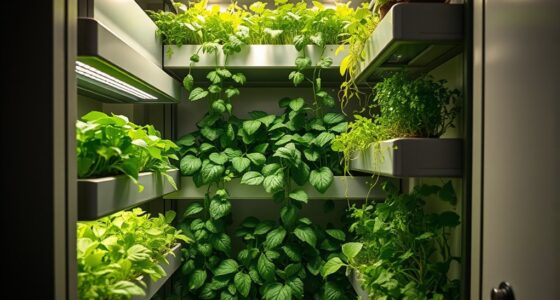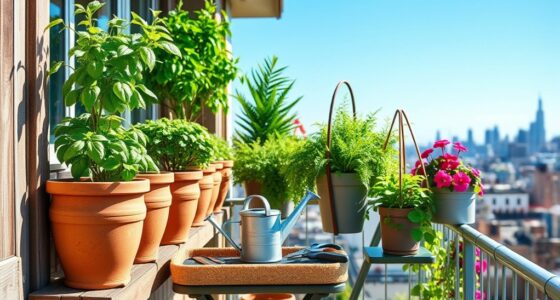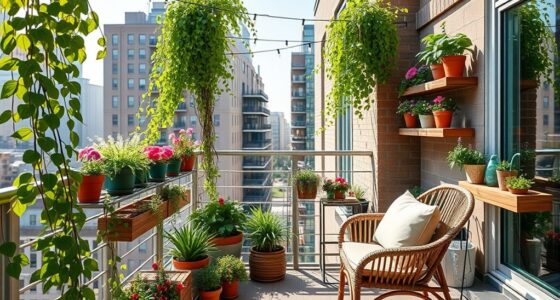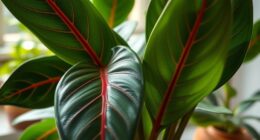To save bees and support pollinators in your city, create a garden full of native plants that bloom at different times, providing continuous nectar and pollen. Avoid chemicals and choose organic practices to keep habitats safe. Include things like bee hotels and bare patches for nesting, and water plants during dry spells. A diverse, pesticide-free space boosts local ecosystems—stay with us to find out how you can turn your garden into a thriving pollinator sanctuary.
Key Takeaways
- Plant native, flowering species that bloom at different times to provide continuous nectar and pollen sources for urban pollinators.
- Avoid pesticides and herbicides; use organic practices to create a safe environment for bees and butterflies.
- Incorporate diverse plant layers, including ground covers, shrubs, and tall flowers, to mimic natural habitats and support various pollinators.
- Provide nesting sites such as bee hotels, bare patches, or leaf litter to encourage pollinator reproduction and shelter.
- Maintain the garden with minimal disturbance, regular watering, and deadheading to promote ongoing blooms and healthy pollinator populations.

Urban areas may seem like unlikely places for pollinator gardens, but with a little planning, you can create a vibrant haven for bees, butterflies, and other beneficial insects right outside your door. The key is selecting the right plants and maintaining your garden effectively. Native plant selection plays a fundamental role here because native plants are better adapted to your local environment, providing essential nectar and pollen sources that support local pollinators. When choosing plants, focus on species that bloom at different times of the year to guarantee a continuous food supply. Incorporate a mix of flowering plants, such as goldenrod, milkweed, coneflowers, and bee balm, which attract a wide variety of pollinators. Avoid non-native, invasive species that can disrupt local ecosystems and replace them with native alternatives for a healthier pollinator population.
Create a vibrant pollinator garden with native plants blooming throughout the year.
Once you’ve selected your native plants, it’s important to develop a routine for garden maintenance that encourages pollinator activity. Keep the garden free of pesticides and herbicides, as these chemicals can harm insects. Instead, opt for organic gardening practices by hand-pulling weeds and using natural fertilizers like compost. Deadheading spent flowers can promote more blooms and extend the flowering season, providing continuous nourishment for pollinators. Additionally, allow some areas of your garden to remain undisturbed, offering shelter and nesting sites for bees and butterflies. Layering plants of different heights and textures creates a more inviting habitat, mimicking natural ecosystems and encouraging diverse pollinator visits.
In terms of practical garden maintenance tips, assure your plants are healthy and resilient by watering deeply during dry spells and mulching to retain soil moisture. Regularly monitor your garden for pests and signs of disease, addressing issues promptly with eco-friendly methods. Keep your garden tidy but not overly manicured; leaving some leaf litter or bare patches can serve as nesting sites. Installing bee hotels or small rock piles can also provide safe spaces for solitary bees to nest, further supporting local pollinator populations. Using pollinator-friendly plants can further enhance your garden’s ability to attract a diverse array of beneficial insects.
Creating a pollinator-friendly urban garden isn’t complicated, but it does require intentionality. By choosing native plants suited to your climate and adhering to garden maintenance tips that promote a healthy, chemical-free environment, you’ll foster a thriving ecosystem right outside your door. Not only will you help save the bees and other pollinators, but you’ll also enjoy a beautiful, lively space that benefits both your neighborhood and the environment. With a little effort, your urban garden can become a crucial refuge for pollinators in the heart of the city.
Frequently Asked Questions
How Can I Attract Bees to a Small Balcony Garden?
To attract bees to your small balcony garden, focus on balcony container planting with bee-friendly plants like lavender, bee balm, and marigolds. Create a bee-friendly balcony design by including diverse flowering plants that bloom at different times. Avoid pesticides and provide shallow water sources. Keep your plants healthy and vibrant, and bees will naturally visit. This approach makes your space inviting for pollinators while enhancing your urban garden’s beauty.
What Are the Best Native Plants for Urban Pollinator Gardens?
When choosing native plants for your urban pollinator garden, focus on native plant selection that attracts a variety of pollinators. Opt for flowers like coneflowers, bee balm, and milkweed, which support pollinator diversity. These plants thrive locally, require less maintenance, and provide essential nectar and pollen. By planting a diverse mix, you’ll create a vibrant habitat that attracts bees, butterflies, and other pollinators, boosting your garden’s ecological health.
How Do I Maintain a Pollinator Garden Year-Round?
To maintain a pollinator garden year-round, you should plan seasonal planting to guarantee blooms throughout the year. Use composting techniques to keep your soil rich and healthy, supporting vibrant plants. Regularly water and deadhead flowers to promote growth. During off-seasons, add mulch to protect roots. This approach keeps your garden thriving, attracts pollinators year-round, and makes gardening easier and more sustainable.
Are There Any Bee-Friendly Plants That Thrive in Shade?
Think of shade as a quiet sanctuary where bee-friendly plants can flourish. You’ll find shade-loving plants that serve as essential bee habitat plants, even in darker corners. Plants like astilbe, foamflower, and lungwort thrive without direct sunlight, offering nectar and shelter. By planting these, you turn shadowy spots into bustling bee havens, proving that even in dimness, life and pollination can thrive, enriching your garden’s hidden symphony.
How Can I Protect Urban Bees From Pollution?
To safeguard urban bees from pollution and support their health, you should reduce exposure to urban pollution sources whenever possible. Avoid planting near busy roads and advocate for green spaces. Provide clean, pesticide-free plants in your garden, and support local policies that improve air quality. By creating a healthier environment, you help boost bee health and guarantee these essential pollinators thrive even amidst urban pollution.
Conclusion
Even in the heart of the city, your small garden can become a thriving oasis for pollinators. While skyscrapers rise around you, your efforts create a vibrant haven for bees and butterflies. It’s a surprising contrast—urban noise versus the gentle hum of pollinators. By planting thoughtfully, you transform concrete chaos into a sanctuary of life, proving that even tiny spaces can make a big difference for nature’s tiny heroes.









